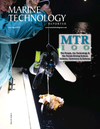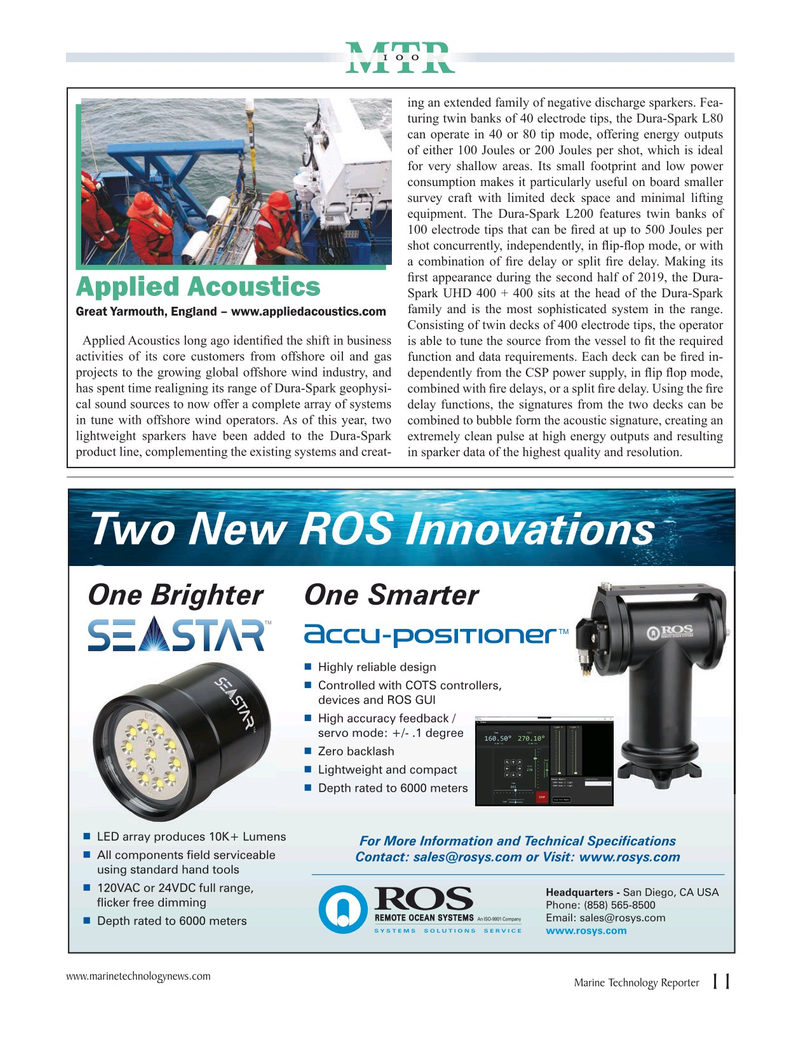
Page 11: of Marine Technology Magazine (July 2020)
Read this page in Pdf, Flash or Html5 edition of July 2020 Marine Technology Magazine
100
MTRMTR ing an extended family of negative discharge sparkers. Fea- turing twin banks of 40 electrode tips, the Dura-Spark L80 can operate in 40 or 80 tip mode, offering energy outputs of either 100 Joules or 200 Joules per shot, which is ideal for very shallow areas. Its small footprint and low power consumption makes it particularly useful on board smaller survey craft with limited deck space and minimal lifting equipment. The Dura-Spark L200 features twin banks of 100 electrode tips that can be ? red at up to 500 Joules per shot concurrently, independently, in ? ip-? op mode, or with a combination of ? re delay or split ? re delay. Making its ? rst appearance during the second half of 2019, the Dura-
Applied Acoustics
Spark UHD 400 + 400 sits at the head of the Dura-Spark family and is the most sophisticated system in the range.
Great Yarmouth, England – www.appliedacoustics.com
Consisting of twin decks of 400 electrode tips, the operator
Applied Acoustics long ago identi? ed the shift in business is able to tune the source from the vessel to ? t the required activities of its core customers from offshore oil and gas function and data requirements. Each deck can be ? red in- projects to the growing global offshore wind industry, and dependently from the CSP power supply, in ? ip ? op mode, has spent time realigning its range of Dura-Spark geophysi- combined with ? re delays, or a split ? re delay. Using the ? re cal sound sources to now offer a complete array of systems delay functions, the signatures from the two decks can be in tune with offshore wind operators. As of this year, two combined to bubble form the acoustic signature, creating an lightweight sparkers have been added to the Dura-Spark extremely clean pulse at high energy outputs and resulting product line, complementing the existing systems and creat- in sparker data of the highest quality and resolution. 7ZR1HZ526,QQRYDWLRQV 2QH%ULJKWHU2QH6PDUWHU
Q +LJKO\UHOLDEOHGHVLJQ
Q &RQWUROOHGZLWK&276FRQWUROOHUV
GHYLFHVDQG526*8,
Q +LJKDFFXUDF\IHHGEDFN
VHUYRPRGHGHJUHH
Q =HUREDFNODVK
Q /LJKWZHLJKWDQGFRPSDFW
Q 'HSWKUDWHGWRPHWHUV
Q /('DUUD\SURGXFHV./XPHQV )RU0RUH,QIRUPDWLRQDQG7HFKQLFDO6SHFLILFDWLRQV
Q $OOFRPSRQHQWVILHOGVHUYLFHDEOH &RQWDFWVDOHV#URV\VFRPRU9LVLWZZZURV\VFRP
XVLQJVWDQGDUGKDQGWRROV
Q 9$&RU9'&IXOOUDQJH +HDGTXDUWHUV6DQ'LHJR&$86$
IOLFNHUIUHHGLPPLQJ 3KRQH (PDLOVDOHV#URV\VFRP
Q 'HSWKUDWHGWRPHWHUV
ZZZURV\VFRP www.marinetechnologynews.com
Marine Technology Reporter 11
MTR #6 (1-17).indd 11 8/12/2020 3:09:57 PM

 10
10

 12
12
